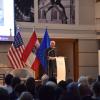
We are delighted to announce that IIASA has been accepted as a full member of the EU Science Diplomacy Alliance, a collaborative initiative launched under the auspices of several Horizon 2020 science diplomacy projects, to sustain and grow their networks, impact, and momentum.
Science diplomacy is a founding principle of IIASA. Since 1972, the institute has been taking a leading role in promoting science diplomacy and fostering debates about how science can help build trust between nations and support diplomatic efforts and foreign policies. With global problems becoming more complex and the world more divided, the value of science diplomacy has again surfaced and is now widely acknowledged as an essential tool to foster relations between nations and to ensure that effective multilateral decision-making leads to collective evidence-based policies and actions.
IIASA is ideally positioned to support and contribute to the aims and objectives of the alliance, which serves as a hub for cooperative activities and voluntary coordination between its members. The alliance relies on its membership community and networks to highlight and select different areas and innovative activities to be pursued to address a great variety of societal challenges over time. Its objectives include encouraging collaboration and knowledge sharing between members; supporting information exchange and raising awareness around pressing issues; training, education, and institutional capacity building; connecting and nurturing science, technology, and innovation in support of the diplomatic community; keeping track of European Union science diplomacy activities; and providing advice to science diplomacy stakeholders.
As a new member of the alliance, IIASA recently contributed to the Inventing a Shared Science Diplomacy for Europe (InsSciDE) Horizon 2020 Concluding Conference in Paris, France, under the theme, New Horizons for Science Diplomacy. Experts from InsSciDE and the EU Science Diplomacy Alliance met with senior scholars, policy experts, and government officials from the vast field of science diplomacy practice to examine possible pathways to a shared science diplomacy for Europe, looking retrospectively from the launch of the InSciDE project to the establishment of the alliance. IIASA contributed to discussions on the next steps needed in science diplomacy.
“Shared global challenges will not be resolved unilaterally, and no nation will achieve a sustainable future in isolation. We look forward to building new relationships and forging strong collaborative ties with our partners in the EU Science Diplomacy Alliance and to bring our collective expertise to bear on the many challenges society faces today,” concludes IIASA Director General Albert van Jaarsveld.
For more information about the EU Science Diplomacy Alliance, please visit: https://www.science-diplomacy.eu/
News

26 July 2024
Navigating new horizons to protect human and planetary health

14 June 2024
IIASA Leadership visits Washington DC

05 June 2024
